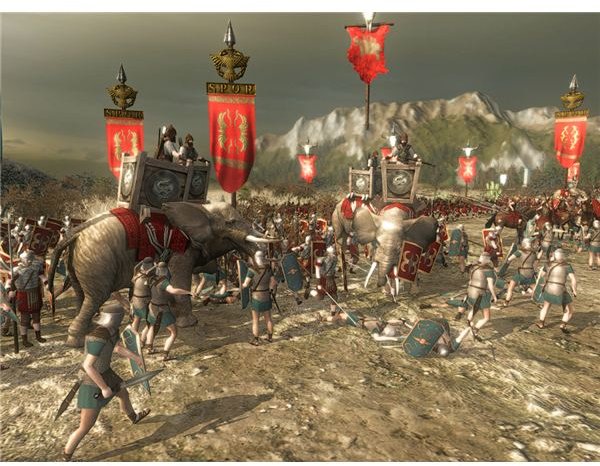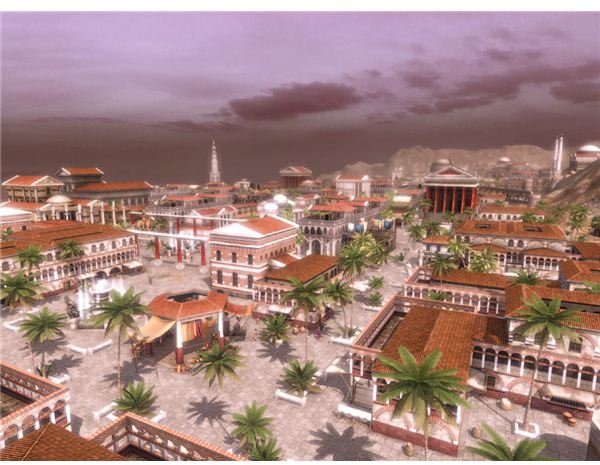Grand Ages: Rome Review, RTS and City Building

Overview
The Roman Empire has offered rich pickings for game developers over the years. There have been several titles inviting you to relive the glory of Rome. The latest effort to hit the stores is Grand Ages: Rome. This is a predictable blend of poorly done real time strategy warfare and nicely realised city building. It is a solid, attractive title with an interesting single player campaign, but the lack of innovation is a disappointment. The saying familiarity breeds contempt comes to mind.
Game-Play (3 out of 5)
Each level in Grand Ages: Rome challenges you to complete a number of objectives. There is a tutorial for building and one for warfare, but anyone who has played a game in this genre before will find it very easy to pick up. The campaign map assigns you various cities to develop and you can choose which missions to do. Each one has a back story and there is an attempt to offer some character development. You can choose sides impacting on the missions that are available down the line. You are also rewarded for success with new traits and resource bonuses. Despite the effort, the stories add little to the experience and you never really feel like a character carving a path through history.
The building mechanic is similar to titles like Pharaoh. You place structures out and try to encourage your city to grow. Many of the buildings have clear interdependencies. You need food to attract people. You need people to work on gathering resources such as wood, bricks, and stone, which in turn allow you to build more structures. Pig farms feed butcher shops and the more quality food you produce, the more skilled people you attract. You can cater to religion, provide entertainment, and research improvements in your schools. It is relatively easy to balance your resources and keep everyone happy.
The gameplay is identical to city builders of old with a few important distinctions. All of your buildings are available from the start which seems great at first. There is a reason these kinds of games usually allow you to develop new buildings over time however, as it keeps you interested. The fact that you can try everything out in your first few levels leaves no surprises, and it means the cities feel boring quickly. The developers have also dispensed with the notion that goods travel, so as soon as you build the required pig farm, you can supply your butcher. And unlike Pharaoh, you aren’t waiting for a man to drag the goods through the streets.
Grand Ages: Rome falls down when it comes to the real-time combat. The city building aspect is solid with a decent interface. Perhaps it would have been better if they had focussed extra effort on that and just dispensed with the combat altogether. There is nothing tactical or particularly enjoyable about churning out units and clicking on a location for them to run to. The AI is rudimentary and there is no tactical depth here at all. This is real-time scrapping - it doesn’t deserve the strategy tag.
Graphics (5 out of 5)
The main indication that this game is not several years old comes from the visual style. The gameplay has not moved on, but the action looks lovely. The buildings are detailed. You can zoom in and watch your citizens scurrying around the streets busily engaged in their daily tasks. The modelling and animation work is very good. The environments look lush and realistic, and the weather and lighting changes as the time ticks by. Although the game looks great at close quarters, you do spend the majority of your time zoomed out, so the intricate animation and level of detail could easily be lost on you. The interface and the menus are also attractive and even better, since they are very easy to use. The icons are recognisable and the characters are well drawn. Overall the art standard is high and this is a good looking city builder.
Multiplayer (3 out of 5)
The option of multiplayer was an unexpected addition and there are six different modes on offer. You can play co-operatively or compete for glory. The modes see you fighting to reach a money target, build monuments, or control territory. Multiplayer in a city building game is a definite rarity, so this is a surprise inclusion and human opponents certainly provide more of a challenge than the game AI.
System Requirements
You are going to need a 2GHz processor, a DirectX 9 compatible 128MB graphics card (GeForce 6600 or better), 1GB of RAM and 1.5GB of hard drive space. It’s not too taxing at all considering the graphical quality, although it must be admitted that the scope of the individual levels is never all that big. Battles tend to be in fairly low numbers as well, and we certainly aren’t talking about something on the epic scale of Rome: Total War.
Overall (3 out of 5)
This was developed by Haemimont Games, a Bulgarian developer who have released several historically based titles. They have even released a few Rome based games before with little success. There can be no doubt they have learned along the way and made huge improvements. Grand Ages: Rome is a solid city builder with good graphics and it provides an enjoyable experience in the short term. It is quite interesting at first, but after a few games the monotony sets in. The combat is a big letdown throughout, and the inclusion of a multiplayer option is not enough to merit a really strong score. As much as the city building aspect is enjoyable, it is also hopelessly derivative and there is no attempt to innovate whatsoever.
Screenshots



